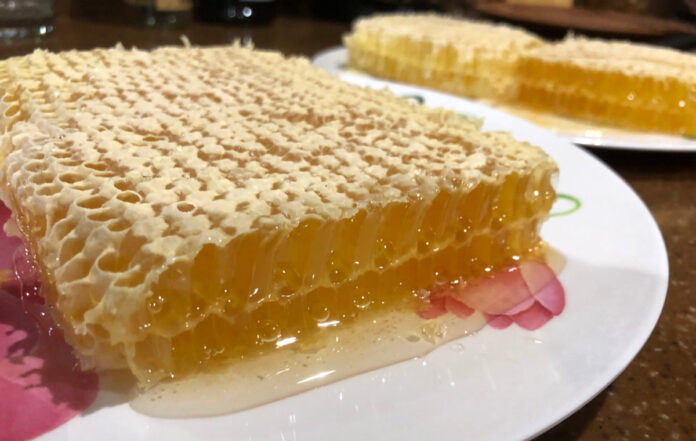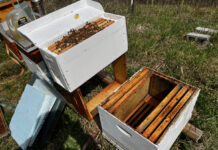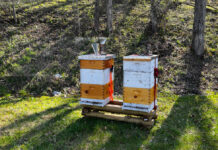We harvested our first honey yesterday. Technically, we harvested our first comb honey, a frame of honeycomb made by the bees with about four pounds of honey encapsulated into it. As seen in the photo above, we cut the honey off the frame, creating rectangular chunks that we could fit into Tupperware containers. Two of these went into the freezer for temporary storage and the other one stayed out to be eaten.
We froze the extra comb as a precaution. Freezing kills any wax moth eggs and larvae that may be present in the hive. We don’t have wax month, as far as we know, but we played it safe. The last thing someone wants to do is open their comb honey after a few weeks and see something crawling around in there.
The honey itself was delicious! We made biscuits from scratch and enjoyed them with the honey for breakfast.
How to Eat Comb Honey
A few generations ago, comb honey was the predominant way to get honey. There was no plastic foundation and many casual bee keepers didn’t buy wax foundation. They also lacked the expensive equipment to remove the honey from the comb and bottle it.
Back then, a saucer or mason jar of comb honey was as common on the table as a crock of butter, and they spread both on biscuits, flapjacks and other foods.
Today, people need to be taught how to eat comb honey all over again. So here are a few suggestions:
Yes, you can cut off a chunk of comb honey and eat it. The bees wax is edible. However, most people who pop a chunk of comb honey into their mouths will chew it until the flavor is gone and then spit out and discard the wax.
Eating comb honey plain is fine, but it is even better when accompanied by another food. We had crackers with a slice of brie cheese and a chunk of comb honey on top. Delicious!
I like to run a knife through the top have of the comb, scooping up honey and wax, and spread it on a warm biscuit, piece of toast, corn bread, etc. The warmth starts to melt the wax, and the result is all the flavor of honey with a silky smooth texture. You won’t even notice you’ve eaten the wax.
Pair your comb honey with other ingredients, including nuts and cheeses. Add it to your favorite sandwich. Anyone who likes to blend sweet with savory should try honey or comb honey as the sweet component.
How We Produce Comb Honey
Seven or eight out of the ten frames in my honey supers have foundation in them, but the remaining two or three don’t. These be the frames on which the bees produce comb honey.
Beekeepers use plastic foundation in the frame because it reinforces the frame when you spin it in the honey extractor, which uses centrifugal force to propel the honey out of the comb. A frame full of comb honey with no reinforcement, like we just cut apart, is likely to fly apart under that much force. A frame with plastic in the center, or with wire reinforcing the wax foundation, can hold up to the spinning and emerge intact and ready for re-use the following year.
When given pre-existing comb, the bees can produce more honey than they will starting with empty frames. Why? Because bees spend an inordinate amount of resources to produce the wax and make the honeycomb. When you give them existing comb, they can use that time to produce honey instead. That’s what most beekeepers want.
Harvesting More Honey
Our plans are to harvest more honey, including the traditional kind you store in a jar, before the end of August. I’m hoping for 80 or more pounds. Check back for an update in three weeks.







